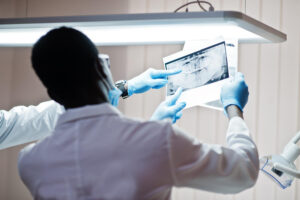Sleep apnea, a condition characterized by intermittent pauses in breathing during sleep, often remains undiagnosed despite its significant impact on health and well-being. Understanding its symptoms is paramount for timely sleep apnea treatment and improved quality of life.
What is Sleep Apnea?
Sleep apnea, a potentially serious sleep disorder, remains largely unrecognized despite its widespread prevalence. Sleep apnea, which is characterized by frequent breathing interruptions while sleeping, interferes with the natural sleep cycle and results in fragmented, nonrestorative sleep. These disruptions may seem innocuous at first glance, but the consequences extend far beyond mere fatigue.
Untreated sleep apnea can significantly impact overall health and well-being, increasing the risk of cardiovascular disease, hypertension, stroke, and diabetes. Furthermore, it impairs cognitive function, diminishes quality of life, and exacerbates mood disorders. Given these far-reaching effects, recognizing the symptoms of sleep apnea is paramount for early detection and intervention.
SYMPTOMS OF SLEEP APNEA
1. Snoring
Snoring is a common occurrence during sleep, often dismissed as a harmless nuisance. However, in the context of sleep apnea, snoring takes on a different significance. It becomes an audible indicator, signaling potential breathing disturbances and sleep fragmentation. Unlike the rhythmic, soft snoring typical of a restful night’s sleep, snoring associated with sleep apnea tends to be louder and more irregular.
The underlying mechanism of snoring in sleep apnea involves the relaxation of throat muscles, leading to partial obstruction of the airway. As air passes through the narrowed airway, it causes the surrounding tissues to vibrate, producing the characteristic sound of snoring. This obstruction can escalate into apneic episodes, where breathing temporarily ceases, further disrupting sleep.
It’s essential to distinguish between benign snoring and snoring indicative of sleep apnea. While occasional snoring may be harmless, persistent and disruptive snoring, especially when accompanied by gasping or choking sounds, warrants attention. Individuals with sleep apnea often experience snoring that is loud enough to disturb their bed partner’s sleep and may persist throughout the night.
2. Pauses in Breathing
In the realm of sleep apnea, silence can be just as telling as sound. Pauses in breathing, known as apneas, represent a silent disruption to the natural rhythm of sleep. During these episodes, airflow is obstructed, causing breathing to temporarily stop. This interruption triggers a cascade of physiological responses, including arousal from sleep, oxygen desaturation, and activation of the body’s stress response.
Apneas can manifest in different forms, ranging from brief interruptions to prolonged cessations of breathing. In obstructive sleep apnea (OSA), the most common form of the disorder, airway obstruction leads to complete or partial closure of the throat, resulting in apneic episodes. Central sleep apnea (CSA), less prevalent but equally consequential, arises from a failure of the brain to send appropriate signals to the respiratory muscles.
The frequency and duration of apneic episodes vary among individuals with sleep apnea. Some may experience sporadic pauses in breathing, while others endure frequent and prolonged apneas throughout the night. Regardless of the pattern, each apneic episode disrupts the continuity of sleep, fragmenting rest and depriving the body of vital oxygen.
3. Excessive Daytime Sleepiness
Excessive daytime sleepiness (EDS) stands as a pervasive consequence of untreated sleep apnea, extending far beyond mere fatigue. Unlike the typical tiredness experienced after a restless night, EDS permeates daily life, impairing cognitive function, productivity, and overall well-being.
At its core, EDS reflects the inability to stay awake and alert during the day, despite having had sufficient opportunity for sleep. This persistent drowsiness can manifest in various ways, from struggling to stay awake during meetings or lectures to nodding off while driving or engaging in other activities requiring attention.
The underlying mechanism linking sleep apnea to EDS lies in the disrupted sleep architecture characteristic of the disorder. Apneic episodes trigger frequent arousals from sleep, preventing individuals from reaching deeper, restorative stages of sleep. As a result, despite spending adequate time in bed, individuals with sleep apnea fail to attain the rejuvenating sleep necessary for optimal daytime functioning.
The consequences of EDS extend beyond mere inconvenience, posing significant risks to safety and quality of life. Impaired alertness and concentration increase the likelihood of accidents and errors, both at home and in the workplace. Furthermore, EDS can strain interpersonal relationships, as individuals may struggle to remain engaged and attentive during social interactions.
4. Morning Headaches
Waking up with a headache can be a jarring start to the day, yet for many individuals with sleep apnea, it’s a recurring occurrence. Morning headaches represent another subtle yet significant symptom of the disorder, often stemming from the physiological consequences of nocturnal breathing disturbances.
The development of morning headaches in sleep apnea is multifaceted, with various factors contributing to their onset. Central to this phenomenon is the intermittent drop in blood oxygen levels and the simultaneous rise in carbon dioxide levels during apneic episodes. These fluctuations trigger vascular changes and inflammation within the brain, culminating in headache symptoms upon awakening.
The nature of morning headaches in sleep apnea differs from typical tension headaches or migraines. While stress or tense muscles can result in tension headaches and changes in the blood vessels and neurological triggers can result in migraines, sleep apnea-related morning headaches are primarily due to the hypoxic and hypercapnic effects of not breathing enough at night.
Individuals with sleep apnea may describe their morning headaches as dull, throbbing sensations that dissipate shortly after waking. However, these headaches can persist throughout the day, contributing to overall discomfort and a diminished quality of life. Furthermore, the recurrence of morning headaches may serve as a red flag for undiagnosed or inadequately managed sleep apnea.
5. Irritability and Mood Changes
Sleep apnea doesn’t just disrupt sleep. It can also take a significant toll on emotional well-being, leading to irritability and mood changes that impact both individuals and their relationships. While it may seem unrelated, the link between sleep apnea and mood disturbances is profound and multifaceted.
The chronic sleep fragmentation and oxygen deprivation experienced by individuals with sleep apnea disrupt the delicate balance of neurotransmitters responsible for regulating mood and emotions. Serotonin, dopamine, and norepinephrine levels may become dysregulated, contributing to mood swings, irritability, and even symptoms of depression.
Increased sensitivity to stressors and a decreased threshold for frustration characterize irritability, a common manifestation of mood disturbances in sleep apnea. Minor inconveniences that would typically be brushed off may provoke disproportionate reactions, strain relationships, and exacerbate interpersonal conflicts.
Additionally, individuals with sleep apnea may experience fluctuations in mood throughout the day, with irritability intensifying during periods of excessive daytime sleepiness or following restless nights. This cyclical pattern further compounds the emotional toll of the disorder, creating a vicious cycle of sleep disruption and mood dysregulation.
6. Difficulty Concentrating and Memory Problems
Beyond affecting mood, sleep apnea can also impair cognitive function, leading to difficulties with concentration and memory recall. The cognitive deficits associated with sleep apnea extend beyond mere tiredness, manifesting as a persistent “foggy brain” that hampers daily functioning and productivity.
One of the primary mechanisms underlying cognitive impairment in sleep apnea is the disruption of sleep architecture. Apneic episodes trigger frequent arousals from sleep, preventing individuals from attaining the deep, restorative stages of sleep necessary for optimal cognitive function. As a result, individuals with sleep apnea may experience deficits in attention, processing speed, and memory consolidation.
An inability to sustain mental effort over time or focus attention on tasks is a hallmark symptom of cognitive dysfunction in sleep apnea. Individuals may find themselves easily distracted or forgetful, struggling to maintain productivity and efficiency in their daily activities.
Memory problems represent another common cognitive complaint among individuals with sleep apnea. Sleep plays a crucial role in memory consolidation, with deep sleep stages facilitating the transfer of information from short-term to long-term memory. Disrupted sleep architecture in sleep apnea disrupts this process, impairing the formation and retention of new memories.
7. Frequent Nighttime Urination
Frequent nighttime urination, known as nocturia, is a common yet often overlooked symptom of sleep apnea. While it may seem unrelated, nocturia can disrupt sleep continuity and contribute to the overall burden of the disorder.
The relationship between sleep apnea and nocturia is complex and multifaceted. One contributing factor is the activation of the body’s stress response during apneic episodes, leading to increased production of urine by the kidneys. Additionally, the fluctuations in blood oxygen levels associated with sleep apnea can stimulate the release of hormones that regulate fluid balance and urine production.
For individuals with sleep apnea, frequent nighttime awakenings to urinate disrupt the continuity of sleep, preventing them from attaining deep, restorative sleep stages. This fragmented sleep pattern exacerbates daytime sleepiness and impairs overall sleep quality, perpetuating the cycle of nocturia and sleep disruption.
Nocturia can have significant implications for overall health and well-being. Sleep deprivation resulting from nocturia contributes to cognitive impairment, mood disturbances, and an increased risk of accidents and falls. Additionally, the disruption of sleep architecture can impair immune function and exacerbate existing health conditions, further compromising overall health.
Exploring Sleep Apnea Treatment Options
Effective management of sleep apnea is crucial for restoring restful sleep and reducing the risk of associated health complications. Treatment options for sleep apnea vary depending on the severity of the condition and individual patient factors. Here are some common approaches to managing sleep apnea:
Continuous Positive Airway Pressure (CPAP) Therapy
CPAP therapy is the gold standard treatment for obstructive sleep apnea (OSA). It involves wearing a mask connected to a machine that delivers a continuous stream of air, keeping the airway open during sleep. CPAP therapy effectively prevents apneic episodes and improves sleep quality when used consistently.
Oral Appliance Therapy

Lifestyle Modifications
Making lifestyle changes can significantly improve sleep apnea symptoms. Losing weight, avoiding alcohol and sedatives before bedtime, quitting smoking, and sleeping on your side instead of your back can all help reduce the severity of sleep apnea.
Surgical Interventions
In some cases, surgical procedures may be recommended to address anatomical abnormalities contributing to sleep apnea. Surgical options include uvulopalatopharyngoplasty (UPPP), tonsillectomy, adenoidectomy, and maxillomandibular advancement (MMA) surgery.
Positional Therapy
Positional therapy involves using devices or techniques to encourage sleeping in a non-supine position (on the side) to reduce the likelihood of airway obstruction. Devices such as positional pillows or wearable devices that provide positional feedback can help individuals maintain an optimal sleeping position.
Inspire Therapy
Inspire therapy is a relatively new treatment option for OSA that involves the implantation of a small device in the chest. This device monitors breathing patterns during sleep and delivers mild stimulation to the hypoglossal nerve, which controls tongue movement, to keep the airway open.
Behavioral Therapy
Behavioral therapies, such as cognitive-behavioral therapy for insomnia (CBT-I), can be beneficial for addressing insomnia and sleep-related anxiety often associated with sleep apnea. These therapies aim to improve sleep hygiene, promote relaxation, and address underlying psychological factors contributing to sleep disturbances.
Trust Smile Solutions Orthodontics for your Holistic Sleep Apnea Treatment
Are you seeking top-tier orthodontic care in Edison, Millburn, or Union, NJ, especially for sleep apnea treatment? Look no further than Smile Solutions Orthodontics, where our team’s expertise and cutting-edge technology converge to offer unparalleled care.
With over 20 years of experience and 12,000 patients treated, trust our orthodontists to provide personalized sleep apnea treatment tailored to your needs. Our commitment to excellence extends to flexible payment options, including affordable financing and comprehensive insurance coverage.
Treatments We Offer:
- Conservative Treatments:
- Nasal rinses, decongestants, and special sprays
- Weight loss programs
- Sleep position aids
- Treating underlying health issues
- Medication adjustments
- CPAP Machines
- Intraoral Devices
- Surgery:
- Somnoplasty
- Tonsillectomy/Adenoidectomy
- Uvulopalatopharyngoplasty (UPPP)
- Jaw Surgery
- Nasal Surgery
Don’t let sleep apnea hold you back any longer—take the first step towards a brighter, healthier future with us. Schedule your FREE consultation today.



